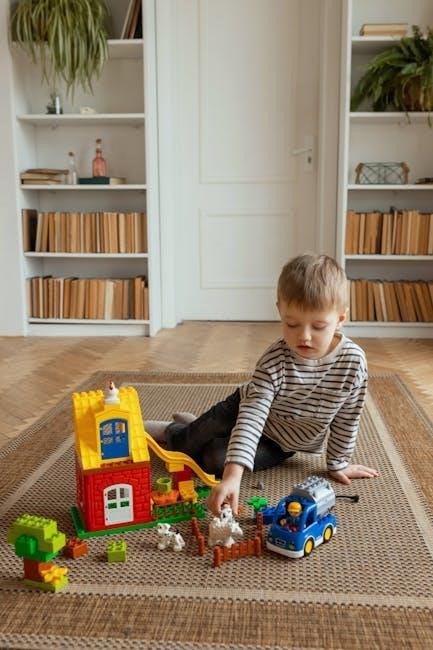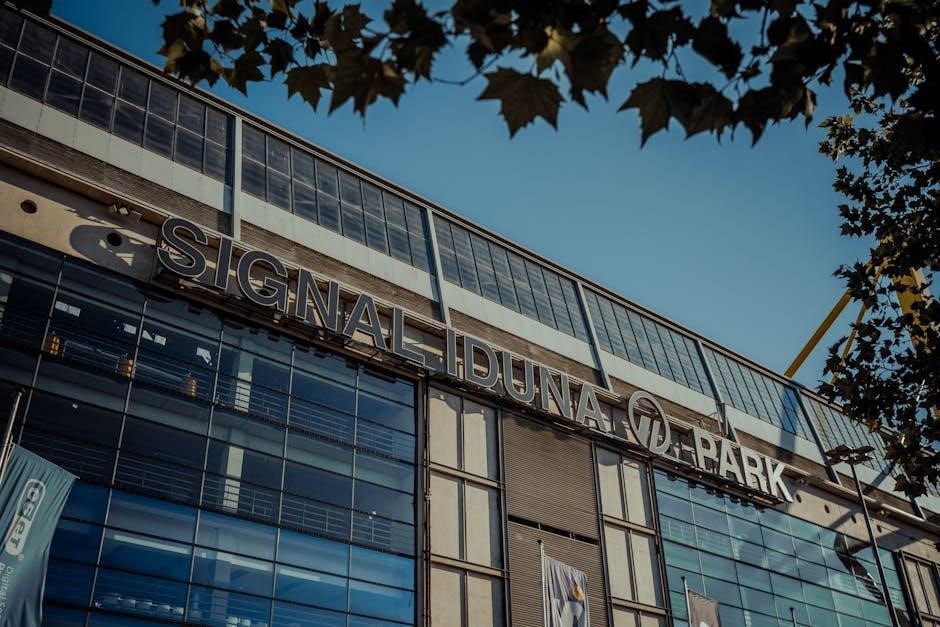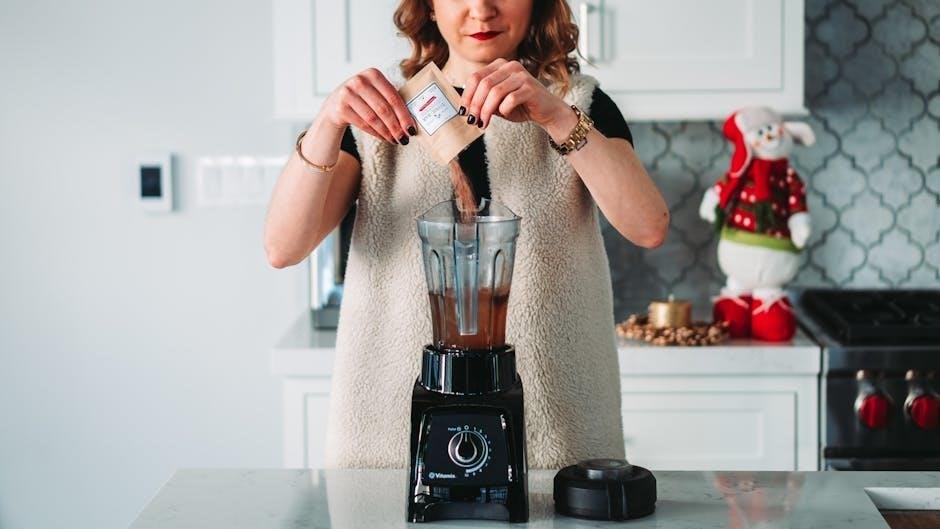Discover the world of FIRST LEGO League (FLL) through comprehensive building instructions. These guides empower teams to design, construct, and program robots, fostering creativity, problem-solving, and teamwork while preparing for competitions.
1.1 Overview of FIRST LEGO League (FLL)
FIRST LEGO League (FLL) is a robotics competition for middle school students, fostering STEM skills through building and programming LEGO robots. Teams tackle real-world challenges with themes like SUBMERGED and MASTERPIECE, using kits like SPIKE Prime and EV3. FLL emphasizes teamwork, innovation, and problem-solving, inspiring future STEM professionals globally.
1.2 Importance of Building Instructions in FLL
Building instructions are essential in FLL, providing clear guidance for constructing robots and mission models. They help teams understand complex mechanisms, reduce confusion, and save time. Detailed step-by-step guides, often with 3D models, ensure reliability and consistency. These instructions act as a foundation for competition readiness, enabling teams to focus on programming and strategy while fostering STEM learning and teamwork. They also encourage innovation by teaching engineering principles like modular design and mechanical advantage, preparing students for real-world challenges.
1.3 Basic Tools and Materials Needed
To get started with FLL building instructions, essential tools include LEGO Education kits like SPIKE Prime or EV3, a set of Allen wrenches, screwdrivers, and a work surface. Materials required are LEGO bricks, motors, sensors, cables, and a robot chassis. Additional supplies like a field mat, mission models, and a robot game table are necessary for competition preparation. These tools and materials help teams bring their designs to life efficiently and effectively.

Robot Design and Building
Explore the journey from basic to advanced robot designs. Learn to construct reliable competition robots using LEGO kits, incorporating motors, sensors, and innovative mechanisms for optimal performance.
2.1 Starter Robot Designs for Beginners
Starter robot designs are perfect for new teams, offering simple yet functional builds. These designs introduce core concepts like motor placement, sensor integration, and basic mechanisms. Many guides provide step-by-step instructions for constructing foundational robots using LEGO kits like SPIKE Prime or EV3. These robots are designed to be both educational and practical, allowing teams to learn essential skills before advancing to more complex designs. They serve as a solid base for future innovations, ensuring a smooth transition into competitive robotics.
2.2 Advanced Robot Mechanisms and Techniques
Advanced robot mechanisms and techniques elevate your FLL designs, enhancing functionality and performance. Explore gear systems, pneumatic components, and modular attachments for precision tasks. Utilize LEGO mechanisms like linear slides and rotational gears to optimize mission execution. Learn how to integrate sensors for autonomous operations and refine your builds with 3D CAD models for intricate designs. These techniques help teams transition from basic robots to sophisticated competition-ready machines, ensuring maximum efficiency and innovation on the field.
2.3 Tips for Building a Reliable Competition Robot
Ensure reliability by using modular designs, stress-testing mechanisms, and securing loose parts. Opt for simple, efficient gear ratios and minimize moving components to reduce failure risks. Regularly maintain and lubricate gears for smooth operation. Use high-quality, durable materials and reinforce weak points. Practice troubleshooting and have backup parts ready. These strategies ensure your robot performs consistently during competitions, avoiding costly failures and maximizing points.
Programming and Software
Master essential programming tools like FTC Blocks, Java, and Python for robot control. Integrate sensors and automate tasks efficiently to enhance robot performance and reliability in competitions.
FTC Blocks is a visual programming tool designed for FLL teams to create robot behaviors intuitively. Using a drag-and-drop interface, teams can easily program actions, sensor integration, and complex sequences. Ideal for beginners, FTC Blocks simplifies coding concepts while enabling the creation of sophisticated robot functions. This tool is essential for translating mechanical designs into functional, competition-ready robots, making programming accessible and enjoyable for all skill levels.
3.2 Text-Based Programming Options (Java, Python)
For advanced teams, text-based programming with Java or Python offers enhanced control and customization. These languages enable complex algorithms, precise motor control, and seamless sensor integration. Java and Python are widely supported in FLL, with libraries like LeJOS for EV3 and Python for SPIKE Prime. Teams can leverage these tools to optimize their robot’s performance, achieving intricate tasks with greater efficiency and accuracy, while developing valuable coding skills for future STEM endeavors.
3.3 Sensor Integration and Automation
Sensor integration is crucial for autonomous robot operation in FLL. Sensors like ultrasonic, color, and touch detectors enable robots to detect objects, recognize colors, and interact with their environment. Automation allows robots to perform tasks independently, such as navigating the field or completing missions without manual input. Proper sensor calibration and programming ensure accurate data processing, enhancing reliability and precision in competition scenarios, making sensor integration a key aspect of advanced FLL robot design and functionality.

Mission Model Building Instructions
Step-by-step guides for constructing mission models, including animated 3D instructions, help teams prepare for FIRST LEGO League challenges. These resources ensure accurate and efficient model assembly for competition success.
4.1 Understanding the Challenge Set and Missions
The Challenge Set is the heart of FLL competitions, featuring a themed field mat and mission models. Teams receive a set of LEGO models divided into bags, each corresponding to specific missions. Understanding the Challenge Set is crucial for designing robots to complete tasks efficiently. The field mat serves as the competition arena, while mission models represent real-world challenges. Teams must study and analyze the set to strategize and build robots capable of achieving maximum points during matches.
4.2 Step-by-Step Guides for Mission Models
Step-by-step guides for mission models provide detailed instructions on assembling and integrating LEGO elements. These guides align with the annual FLL challenge themes, ensuring teams understand how to build functional models. Each guide includes parts lists, assembly tips, and mission-specific strategies. Teams use these resources to replicate models accurately, ensuring compatibility with their robots. The guides also offer insights into optimizing designs for competition, helping teams prepare effectively for the robot game.
4.3 Animated and Interactive 3D Instructions
Animated and interactive 3D instructions enhance the building experience by providing visual, step-by-step guidance. These resources allow teams to explore mission models from multiple angles, simplifying complex builds. Interactive features enable users to zoom, rotate, and animate models, making assembly more intuitive. Many instructions are organized by mission and include part locations, streamlining the process. This innovative approach helps teams build accurately and efficiently, preparing them for competition with confidence.

Robot Game Table Setup
Set up the game table using official match instructions or DIY folding guides. Basic tools and woodworking skills are required for assembly. Ensure accurate placement for competition readiness.
5.1 Official Match Table Building Instructions
The official match table for FIRST LEGO League requires precise assembly to ensure competition readiness. Use the provided blueprints to construct a sturdy table measuring 2360 x 1140 mm. The table must accommodate the Challenge Set mat and allow robots to operate seamlessly. Ensure all edges are smooth and the surface is level; Detailed instructions, including materials like plywood and specific tools, are available for download. Follow guidelines carefully to meet competition standards.
5.2 DIY Folding Table Instructions
Construct a portable and cost-effective folding table for FLL competitions using basic woodworking tools. Cut plywood to 2360 x 1140 mm for the surface and attach folding legs. Ensure the table is sturdy and level. Add a smooth finish to prevent damage to the Challenge Set mat. Detailed plans and material lists are available online. This DIY option is ideal for teams needing a reliable yet affordable practice or competition surface.
5.3 Placement and Calibration Tips
Ensure the robot game table is placed on a flat, stable surface. Align the Challenge Set mat precisely, securing it with tape if needed. Calibrate the robot’s sensors and motors for accurate performance. Test the robot’s navigation and mission execution on the table before competitions. Proper placement and calibration are crucial for consistent results and maximizing points during matches.

Resources and Tutorials
Access downloadable guides, online courses, and community forums for building and programming robots. These resources provide step-by-step instructions and expert tips to enhance your FLL experience.
6.1 Downloadable Building Guides and Manuals
Find comprehensive downloadable guides and manuals for building FIRST LEGO League robots. These resources include step-by-step instructions, CAD models, and mission-specific blueprints. They are designed to help teams of all skill levels, from beginners to advanced participants. Manuals cover topics like robot design, mechanism construction, and programming integration. Utilize these tools to streamline your building process and ensure your robot is competition-ready. Access these resources through official FLL websites and community platforms.
6.2 Online Courses and Workshops
Enroll in online courses and workshops tailored for FIRST LEGO League participants. These programs offer hands-on training in robot design, programming, and mission-specific strategies. Resources include LEGO Education SPIKE Prime and EV3 lessons, FTC Blocks tutorials, and advanced robotics techniques. Many courses are designed for educators and mentors to guide students effectively. They also provide downloadable lesson plans and software tools to enhance learning and preparation for competitions.
6.3 Community Forums and Team Collaborations
Join vibrant community forums where FIRST LEGO League teams share ideas, ask questions, and showcase their projects. Collaborate with peers and mentors to refine robot designs and troubleshoot challenges. These platforms foster creativity and innovation, offering valuable insights and resources. Engage in discussions on building techniques, programming strategies, and competition tips, helping teams grow and succeed together.
Season-Specific Challenges
Each FLL season introduces unique themes and mission models, requiring tailored building instructions. Teams adapt to new challenges annually, ensuring dynamic competition and continuous innovation in robot design.
7.1 SUBMERGED (2024-2025) Building Instructions
The SUBMERGED season focuses on underwater-themed missions, requiring precise robot designs. Animated 3D instructions guide teams through building mission models like coral reefs or submarine bases. Each model is detailed with LEGO pieces, organized by bags for clarity. Tips on modular building and waterproofing mechanisms are included to enhance functionality. These resources ensure teams can construct robots capable of performing underwater-themed tasks efficiently and effectively in competition.
7.2 MASTERPIECE (2023-2024) Mission Models
The MASTERPIECE season focuses on art and creativity, with mission models inspired by famous works of art. Teams build and program robots to interact with these models, such as painting machines or sculpture sorters. Animated 3D instructions guide teams through constructing models like the “Art Gallery” or “Sculpture Garden.” Each model is detailed with LEGO pieces, organized by bags for clarity. These instructions help teams design robots that align with the artistic theme while meeting competition requirements.
7.3 Adapting Instructions for New Themes
Each FLL season introduces a unique theme, requiring teams to adapt building instructions to new challenges. Teams must understand the theme’s requirements, modify existing models, and integrate new elements. Resources like animated 3D guides and community forums help teams customize their builds. Strategies include reviewing past models, testing new mechanisms, and ensuring designs align with the theme’s objectives. Adapting instructions fosters creativity and prepares teams for dynamic competition demands.
Tools and Platforms
Essential tools include LEGO Education kits like SPIKE Prime and EV3, REV controllers, and LEGO EV3. Platforms like 3D CAD models and programming software (FTC Blocks, Java) enhance robot design and functionality.
8.1 LEGO Education Kits (SPIKE Prime, EV3)
LEGO Education kits like SPIKE Prime and EV3 are cornerstone tools for FLL. These kits provide motors, sensors, and programmable hubs, enabling teams to build and program robots. SPIKE Prime is ideal for middle school students, offering intuitive programming and versatile hardware. EV3, with its advanced features, suits more complex designs. Both kits foster creativity, problem-solving, and engineering skills, aligning perfectly with FLL’s mission to inspire STEM learning through hands-on robotics.
8.2 REV Controller Setup and Programming
REV controllers are essential for advanced robot control in FLL. Setup involves configuring hardware and software, ensuring compatibility with LEGO kits like SPIKE Prime. Programming options include Java and Python, enabling precise control. Teams can integrate sensors and motors seamlessly. Proper setup ensures reliable performance during competitions. Tutorials and guides are available to optimize REV controller usage, helping teams achieve peak efficiency and automation in their robot designs.
8.3 3D CAD Models for Advanced Designs
3D CAD models enhance FLL robot design by providing precise blueprints for complex mechanisms. These models allow teams to visualize and customize advanced builds, ensuring accuracy and functionality. They are particularly useful for creating intricate mission models and optimizing robot performance. Experienced teams can leverage CAD software to design innovative solutions, while newcomers can learn from pre-designed templates. This approach fosters creativity and technical skills, preparing teams for high-level competitions and real-world engineering challenges.
Judging and Competition Preparation
Preparation for FLL judging involves refining robot performance, ensuring alignment with competition rules, and rehearsing presentations. Teams must demonstrate technical skills, creativity, and adherence to FLL core values effectively.
9.1 Understanding Judging Rubrics
Understanding FLL judging rubrics is crucial for success. Rubrics assess robot design, programming, and innovation, as well as teamwork and presentation skills. Teams should align their efforts with these criteria to maximize points. Judges evaluate mechanical efficiency, code quality, and problem-solving strategies. Additionally, core values like collaboration and creativity are scored, emphasizing the importance of a well-rounded approach to competition preparation.
9.2 Presenting Robot Design and Programming
Effectively presenting robot design and programming is key to competition success. Teams must clearly communicate their robot’s mechanics, programming logic, and innovative solutions. Judges assess not only technical skill but also creativity and problem-solving. A well-organized presentation, supported by visual aids like 3D models or diagrams, helps showcase the robot’s capabilities. Practicing presentations ensures confidence and clarity, aligning with FLL core values of innovation, teamwork, and Gracious Professionalism™.
9.3 Strategies for Maximizing Points
To maximize points, teams should focus on efficient mission execution, precise robot movements, and strategic programming. Prioritize high-value missions and ensure reliable mechanisms. Optimize robot paths to minimize time waste, and use sensors effectively for accuracy. Understand the scoring system thoroughly to allocate tasks wisely. Regular practice and testing help refine performances, ensuring peak execution during competitions. Balancing speed and precision is key to achieving the highest possible score.
STEM Education and Team Collaboration
FIRST LEGO League promotes STEM education through hands-on learning, fostering teamwork, communication, and problem-solving skills. Building instructions and collaborative challenges inspire creativity and innovation in young minds.
10.1 Fostering Teamwork and Problem-Solving Skills
FIRST LEGO League encourages collaboration, teaching students to work together toward shared goals. Through robot design and mission challenges, teams develop problem-solving abilities, learning to brainstorm, test, and refine solutions. This hands-on approach fosters critical thinking, adaptability, and communication, essential for STEM fields and lifelong learning. Collaborative efforts strengthen teamwork, preparing participants for real-world challenges and nurturing a spirit of innovation and mutual support.
10.2 Encouraging Creativity and Innovation
FIRST LEGO League inspires creativity by allowing teams to design unique robots and solutions. Using LEGO kits and 3D CAD models, students express their ideas freely, fostering innovation. The program encourages experimenting with mechanisms, programming, and designs, sparking imagination and preparing them for future STEM challenges. This creative freedom empowers young minds to think outside the box and develop groundbreaking solutions.
10.3 The Role of Mentors in FLL
Mentors play a crucial role in guiding FLL teams, providing expertise in robot design, programming, and problem-solving. They help students understand challenges, develop creative solutions, and refine their skills. By fostering collaboration and critical thinking, mentors empower teams to excel in competitions and beyond, nurturing essential STEM skills and confidence in young innovators.
This guide provides essential insights into FLL building instructions, emphasizing creativity, problem-solving, and teamwork. Continuous learning and improvement are key to excelling in competitions and beyond.
11.1 Final Tips for Success in FLL
Start early and test designs thoroughly. Simplify mechanisms for reliability and focus on core missions. Utilize online resources and community forums for inspiration. Practice presentation skills to clearly explain designs and strategies. Stay organized, track progress, and embrace continuous improvement. Collaboration and creativity are key to achieving success in FIRST LEGO League competitions and fostering lifelong STEM skills.
11.2 Continuous Learning and Improvement
Encourage teams to embrace a growth mindset by regularly practicing and refining their skills. Utilize online resources, 3D CAD models, and community forums to enhance robot designs. Seek feedback from mentors and peers to identify areas for improvement. Regularly review and adapt strategies to stay competitive. Continuous learning fosters innovation, problem-solving, and adaptability, essential for long-term success in FIRST LEGO League and beyond.

